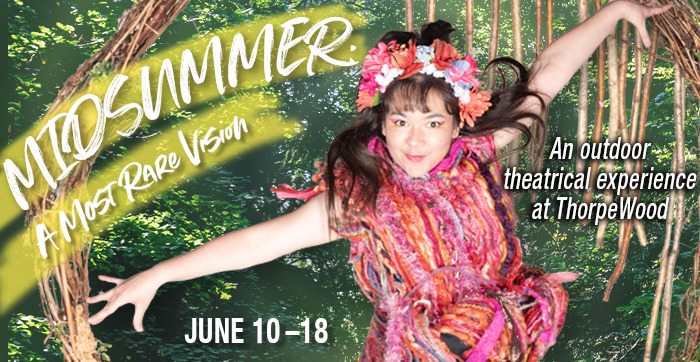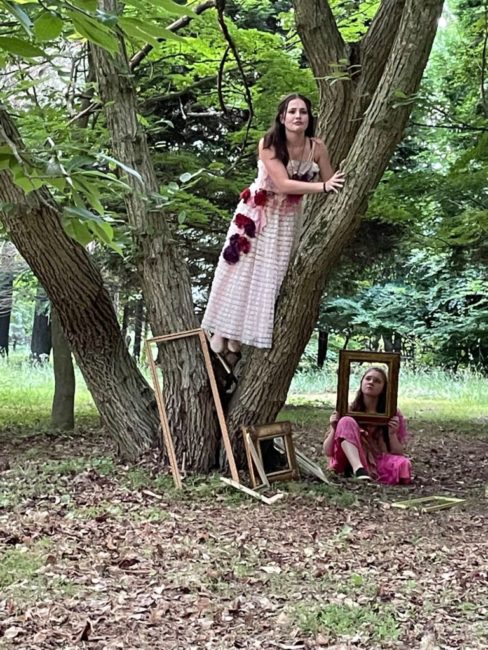I have had a most rare vision. I have had a dream, past the wit of man to say that indeed dreams— rare visions or not— do come true; live theatre with in-person audiences have returned to us once more. The Maryland Ensemble Theatre is at their finest in bringing a most peculiar, wondrous and intriguing theatrical endeavor to those of us who have waited so long to return to the theatre. Directed by Julie Herber, this fascinating, ethereally ephemeral experience— Midsummer: A Most Rare Vision— as a true one of a kind explorative, immersive deconstruction of William Shakespeare’s A Midsummer Night’s Dream. Draped over the exquisite outdoor campus of the ThorpeWood events venue in rustically charming and mountainous Thurmont (right in the hills of Catoctin State Park), an experience like no other awaits theatre-goers of all ages. For those that know Shakespeare and those that don’t, for those intimately familiar with A Midsummer Night’s Dream and those who have never read or seen the play, a sumptuous visual and theatrical feast awaits, enticing and engaging to all.

Truly an ensemble work, the experience is not merely bits of the play scattered about through the woods. There’s singing, dancing, monologue moments, interactive pieces, aerial work, even some improv; there is something for everyone to enjoy and as an added bonus, nature and outdoor lovers will get a uniquely guided tour (from scene-to-scene) by a group of Midsummer Faeries (Lucy Campbell, Mairead Hoyt, Searlait Hoy, Ysa Seltzer Tallulah Hammel, Josie Ritchie, Izzy Woods) all around the enchanting grounds of ThorpeWood over the course of this ‘two-hours’ stage traffic.
With roughly a dozen on the production crew— Sarah Agnello, Brenda Campbell, Hayden Draycott, Keri Hammel, Siobhan Hoyt, Lindsay Mayonado, Rona Mensah, Jeremy Myers, Jen Pagano, Laura Ritchie, LJ Teske— the wonders of the MET’s outdoor adventures never cease to amaze. Four different maps are laid out (and distributed by The Faeries after their inviting opening dance routine, choreographed all around the ‘gathering area’ by Director Julie Herber) giving patrons an idea of where they’re going and hints of what they might see. Of course each group of faeries takes audiences in different directions (everyone will get to see all parts of the experience, just in different orders at different times and pulling off such feats without overlap and crash-happy accidents is a tremendously applaudable effort.) There’s music and even lighting for some of the scenes, no small task as nearly all the scenic encounters take place fully in the open air, often deep in the woods (and occasionally out on a boat in a pond!) Designers Tabetha White and Doug Grove are minimalistic in their approach, letting the actors and their costumes and performances often speak for the experience that the audience is enjoying during each of their scenes. Stage Manager Shayden Jamison deserves a huge round of applause; after taking in the production-experience in its entirety, it leaves the head spinning at just how many things Jamison must have had to coordinate for this show to be such a smashing success.

The aforementioned Faeries (Lucy Campbell, Mairead Hoyt, Searlait Hoy, Ysa Seltzer Tallulah Hammel, Josie Ritchie, Izzy Woods) are not only adorable dancers, but knowledgeable tour guides, coaxing each group through the woods to experience the scenes. As the audience settles into the scene, whether it be immersive, interactive, or observation only, the Faeries take up their roles as Queen Titania’s onlookers (just like the Faeries often do in the Bard’s original work.) Faeries can be seen climbing ladders, crouching into tress, hovering near scenes like little silent spies and it adds an extra layer of theatrical magic to the overall experience. A direct shout-out to Ysa Seltzer and Izzy Woods, the Faeries put in charge of my particular group as they were kind, amusing, and nature-friendly (Miss Woods procured a ‘pet’ cicada early on in the trek and made it an integral and adorably intricate detail to her character— the faerie with the friends of nature always on her.)
The scenes featured the work of various and sundry MET company members playing to their strengths. Music and lyrics were provided by composers Meryl Cullom, Michael Perrie Jr., Noah Summer, and Colin Shultzaberger, to enhance the uniqueness of each scene. And non-musically-inclined scenes featured the work of playwrights and poets: Joy Campbell, Matthew Lee, Jessica McHugh, and Reiner Prochaska. Whether it was ‘overhearing’ “The Conversation”— a scene scripted by Matt Lee— where King Oberon (Tim Seltzer) and Queen Titania (Lia Seltzer) argue in modern dialect over their failing, tempestuous relationship, and their delusional beliefs that each should have full use and charge of the stolen Changeling Child (at this performance, Opal Stout.) or enjoying the hilariously off-kilter musical ditty written by Michael Perrie Jr. and performed by Gené Fouché & Tad Janes, there is something fascinating and wondrous strange for everyone to enjoy.
Perhaps you feel your trek through the Bard’s woods should have meaning and purpose? When you stop at the “Advice From an Ass” section, be sure to ask James McGarvey exactly that. The most audience-interactive feature of the performance, McGarvey— in true Nick Bottom style— delivers advice to anyone asking. (And audiences, as they are so oft to do, will ask what they will. And McGarvey doesn’t miss a beat, finding both humor and levity— much needed in these challenging times— for everyone querying questions.) Need something with a little more hilarity? “The I-Mechanicals” will be the scene for you. Written by Reiner Prochaska and featuring Prochaska along with Ivan Diaz Moros, Ken Poisson, Wilson Seltzer, Rachel Smith, and Laura Stark, this hilariously little improv-based snippet is a blessed far cry from the “play within the play” that happens in Shakespeare’s A Midsummer Night’s Dream. It’s all of the hilarity of the Pyramus and Thisbe scene from the original work, without all of the unnecessary crap. Hats off to Wilson Seltzer and Ivan Diaz Moros as they charge the scene with natural comic timing, a keen understanding of how to work their comedic senses (think spidey-senses of Jedi-Force only improv-comedy) and an overall liveliness that has the audience all but rolling in the grass alongside them during this station.

Shakespeare of course is not without its ‘drama’, not even in the comedies, and that is true of this production as well, but there’s nothing so heavy to mire one into a swamp or make one too melancholy to move forward. What the audiences receive instead are brilliant performances from Hermia (Delaney White) and Helena (Surasree Das) in two separate encounters. The piece entitled “Helena”, written by Jessica McHugh, features Surasree Das in a mercurial and maddening moment somehow just outside of Helena’s life. Stationed at what must assume is a wedding area of the ThorpeWood venue (there’s a beautiful stick archway and log benches with a long aisle), Das races frantically up and down, playing with not only the levels of her emotions in this piece but the levels of her physicality, ultimately ending herself in the dirt and beautifully sienna and rust carpeting of fallen pine needles that haven’t yet moldered away. Das’ performance is a high-octane explosion of feeling and a little bit of humor too. Delaney White, as the titular performer in the piece called “Hermia’’, also written by McHugh, features a more subdued series of moments more reflections than memories. (And this is broadly represented with the picture/mirror frames strewn and strung around her tree grove.) White’s performance is equally compelling and moving but with a vastly different emotional current guiding it forward.
Not into monologue delivery (though how could you not be with those astounding performances?) There’s a gorgeous aria entitled “A Most Rare Vision”, composed by Meryl Cullom, and performed with radiant grace (at this performance) by Jennifer Pagano in a boat. On a pond. At the scene called “Song in a Boat.” Need some of Julie Herber’s signature frenetic movement based work? In addition to the Faeries opening dance, that can be found during “Though She Be But Little” written and voiced by Joy Campbell and performed with fierce intensity by Karli Cole. There’s even an Art Installation, fabricated by Joann Foltz and Milee McDonald. And a conclusion ceremony— “The Wise Man”— written and performed by Ray Hatch to draw the dreamlike experience to a close in an all encompassing circle of audience and performers alike.

The pièce de resistance, at least for this weary mortal traveler, is “Puck’s Flight”, with original music composed by Noah Sommer, featuring Devin Gaither. What Midsummer experience would be complete without the feisty, spirited Puck? And MET’s Midsummer: A Most Rare Vision does not disappoint in this regard. Devin Gaither warms the waiting audience, as they enter the lofty barn, with a few of Puck’s lines before engaging in her artistic specialty— aerial silks. It defies magnificent description and puts all of the tricksy nature of Puck on display, taking the personality of this mischievous faerie to dazzling new heights.
Tis wondrous strange, this fantastical world of theatre, dance, music, verse, poetry, improv and more that Julie Herber and the ensemble of Midsummer: A Most Rare Vision lays before its audiences. No finer way could one spread their arms wide and welcome back the masses than with this unique, explorative, and fantastically engaging experience.
Running Time: Approximately 2 hours walking adventure
Midsummer: A Most Rare Vision has performances through June 18, 2021 on location at ThorpeWood— 12805-A Mink Farm Road in Thurmont, MD. Tickets are available for purchase in advance online.
ALL PERFORMANCS ARE SOLD OUT.
